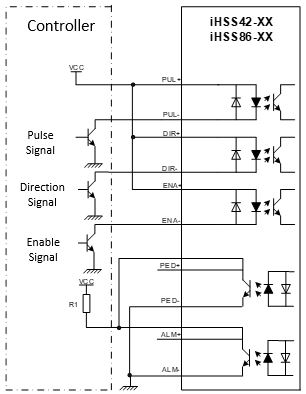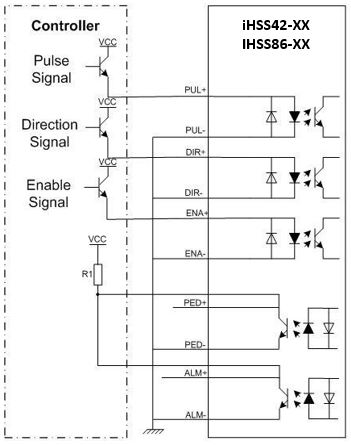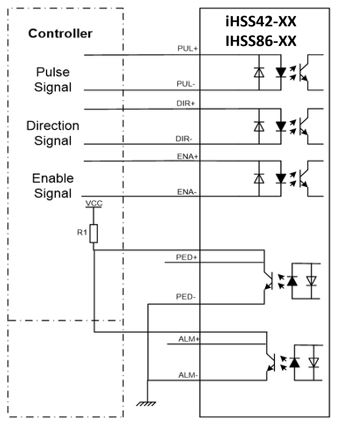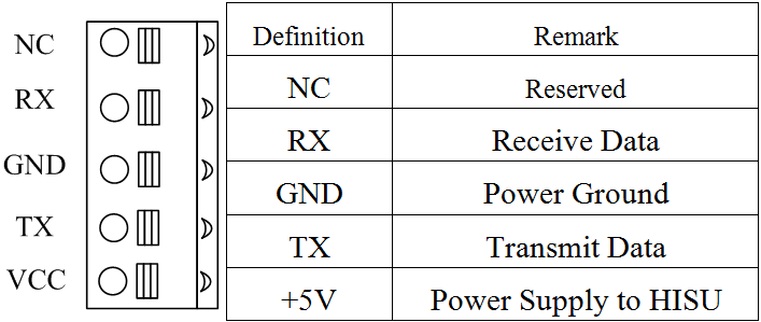
Integrated Stepper Motor closed loop
iHSS42
 Download data sheet
Download data sheetThe iHSSXX merged stepper driver and motor together. This motor system integrates the servo control technology into the digital stepper drive perfectly. Further, this product adopts an optical encoder with high speed position sampling feedback of 50 μs, once the position deviation appears, it will be fixed immediately. This product is combines the advantages of the stepper drive and servo drive, such as lower heat, less vibration, fast acceleration, and so on.
- Cost-effective closed loop stepper motor solution
- High positioning accuracy
- No step losses
- Smooth and reliable moving at low speed
- Compact size
- Pulse Input Mode Pulse + Direction
- Variable current control technology, thus high current efficiency
- Parameters to download via RS232 to PC
- Users can define subdivisions via external Dial-up switches or via software
- Over-current, over-voltage and over-position protections
iHSSXX can be used in various applications such as laser cutters, laser markers, high precision X-Y tables, labelling machines, CNC router, etc. Its unique features make the iHSSXX an ideal choice for applications that require low-speed smoothness by small mounting space.
iHSS stepper:

- Integrated Closed Loop Stepper motor
- Motor frame size: 42 ≙ 42 mm
- Motor rated DC voltage: 24 ≙ 24 V
- Holding torque: 05 ≙ 0.48 Nm / 07 ≙ 0.72 Nm
- Shaft length: no digit ≙ 24 mm / 24 ≙ 24 mm
- Pilot diameter: no digit ≙ 22 mm / 22 ≙ 22 mm
- Square hole distance: no digit ≙ 31 mm / 31 ≙ 31 mm
| Parameters: | Min | Typical | Max | Unit |
|
Input Voltage |
20 |
24 |
50 |
VDC |
|
Output current |
- |
4.5 |
- |
A |
|
Pulse per revolution |
4 |
- |
51,200 |
- |
|
Pulse input frequency |
- |
- |
200 |
kHz |
|
Pulse Voltage |
- |
5 |
24 |
V |
|
Logic Signal Current |
5 |
10 |
16 |
mA |
|
Isolation Resistance |
100 / 500 |
- |
- |
MΩ / V DC |
|
Insulation class |
- |
B |
- |
- |
| Part Name: | iHSS42-24-05 | iHSS42-24-07 | Unit | |
|
Current / phase |
1.2 | 1.2 | A | |
|
Number of phases |
2 | 2 | - | |
|
Holding Torque |
0.48 | 0.72 | Nm | |
|
Inductance / phase |
7.9 | 10 | mH ± 20 % | |
|
Resistance / phase |
3 | 4 | Ω ±10 % | |
|
Inertia |
77 | 110 | g*cm | |
|
Weight |
0.5 | 0.68 | kg |
| Cooling |
Natural cooling or forced air cooling |
|
|
Operating Environment |
Environment |
Avoid dust, oil, fog and corrosive gases |
|
Ambient Temperature |
0 ℃ - 40 ℃ |
|
|
Humidity |
40 %RH - 90 %RH |
|
|
Operating Temperature(motor case) |
0 - 70 ℃ max |
|
| Storage Temperature |
-20 ℃ - 80 ℃ |
|

| Name | Length of motor and drive L | Shaft length SL | Pilot diameter D | Square hole distance HD |
| iHSS42-24-05 | 76 ±1 mm | 24 ±1 mm | 22 mm | 31 mm |
| iHSS42-24-07 | 89 ±1 mm | 24 ±1 mm | 22 mm | 31 mm |
| - | - | - | - | - |
| - | - | - | - | - |

| LED light flashes | Alarm description |
| 1 time | Error occurs when the motor coil current exceeds the drive's current limit. |
| 2 times | Voltage reference error in the drive |
| 3 times | Parameters upload error in the drive |
| 4 times | Error occurs when the input voltage exceeds the drive's voltage limit. |
| 5 times | Error occurs when the actual position following error exceeds the limit |
The iHSSXX have three connectors, one connector for power connections, another one for control signal connections and a third one for RS232 communication connections
|
Power Connector
|
|||
| Pin | Name | I/O | Description |
| 1 | DC+ | I | Power Supply Input (Positive) 20 – 50 VDC; 24 V is typical. Recommended to leave reasonable reserve for voltage fluctuation and back-EMF during deceleration. |
| 2 | GND | GND | Power Ground (Negative) |
CONNECTORS AND PIN ASSIGNMENT (CONTINUED)
|
Control Signal Connector |
|||
|
Pin |
Name |
I/O |
Description |
|
1 |
ALM- |
O |
Alarm Signal: OC output signal, activated when one of the following protection is activated: over-voltage and over current error. They can sink or source MAX 8 mA current at 24 V, respectively 200 mW. The impedance between ALM+ and ALM- is high for normal operation and becomes low when any protection is activated. |
|
2 |
ALM+ |
O |
|
|
3 |
PED- |
O |
In-position Signal: OC output signal, activated when actual motor position reaches to target position. This port can sink or source MAX 8 mA current at 24 V, respectively 200 mW. The impedance between PED+ and PED- is high for normal operation and becomes low when the target position is reached. |
|
4 |
PED+ |
O |
|
|
5 |
ENA- |
I |
Enable signal: This signal is used for enabling/disabling the drive board. By default, high level (NPN control signal) for enabling the drive board and low level for disabling the drive board. It is usually left UNCONNECTED (ENABLED). Please note that the PNP and Differential control signals are on the contrary, namely Low level for enabling. |
|
6 |
ENA+ |
I |
|
|
7 |
DIR- |
I |
Direction Signal: In single-pulse mode, this signal has low/high voltage levels, representing two directions of motor rotation. For reliable motion response, DIR signal should be ahead of PUL signal by 5 μs at least. 3.5 - 24V for DIR-HIGH, 0 - 0.5 V for DIR-LOW. Toggle DIP switch S6 to reverse motion direction. |
|
8 |
DIR+ |
I |
|
|
9 |
PUL- |
I |
Pulse Signal: In single pulse (pulse/direction) mode, this input represents pulse signal, active at each rising or falling edge (Software configurable). 3.5 - 24 V for PUL-HIGH, 0 - 0.5 V for PUL-LOW. For reliable response, pulse width should be longer than 2.5 μs for 200 kHz MAX input frequency.  |
|
10 |
PUL+ |
I |
|
|
RS232 Communication Connector
|
||||
| Pin | Name | Colors at the beige round cable | Colors at the grey flat cable | Description |
| 1 | NC | - | - | Not Connected |
| 2 | RX | Brown-White | Yellow | RS232 Receive data |
| 3 | GND | Blue | Green | Ground |
| 4 | TX | Blue-White | Red | RS232 Transmit data |
| 5 | VCC | - | - | Power Supply 3.3 V to HISU. Attention: For PC software use, leave unconnected! |
Note 1: The RS232 communication port is not isolated. Please use an isolated power supply for the iHSSXX when the PC’s serial port is not isolated
Note 2: Do not plug or unplug the connector when power is on.
Pulses / Rev. (SW 1-SW 4)
Pulses per revolution of the iHSSXX can be configured via DIP switch S1-S4 or by the tuning software. When all S1-S4 are at “ON” positions, the drive will take the setting set by the software. In this case a user can reconfigure via software to a value divisible by 50 between 200 and 50000 pulses. If any bit of S1-S4 is at “OFF” position, the integrated drive board will take micro step resolution setting determined by bit positions of S1-S4. Use the following table for their resolution settings via the DIP switches
|
Pulses / Revolution
|
SW1
|
SW2
|
SW3
|
SW4
|
|
Software Configured / Default
|
On
|
On
|
On
|
On
|
|
800 |
Off |
On |
On |
On |
|
1600 |
On |
Off |
On |
On |
|
3200 |
Off |
Off |
On |
On |
|
6400 |
On |
On |
Off |
On |
|
12800 |
Off |
On |
Off |
On |
|
25600 |
On |
Off |
Off |
On |
|
51200 |
Off |
Off |
Off |
On |
|
1000 |
On |
On |
On |
Off |
|
2000 |
Off |
On |
On |
Off |
|
4000 |
On |
Off |
On |
Off |
|
5000 |
Off |
Off |
On |
Off |
|
8000 |
On |
On |
Off |
Off |
|
10000 |
Off |
On |
Off |
Off |
|
20000 |
On |
Off |
Off |
Off |
|
40000 |
Off |
Off |
Off |
Off |
SW 5: serves to define the activation edge of the input signal, "off" means that the activation edge is the rising edge, while "on" is the falling edge.
SW 6: is used for setting the running direction, “off” means CCW, while “on” means CW.
SW 7: is used for PUL Filter Setting, “off” means Max. PUL frequency is 200 kHz, on means Max. PUL frequency is 100 kHz. Note: When the P22 parameter is 0, the pulse filtering degree is controlled by the SW7 pulse interference filtering dialing code, when set to other non-zero values, SW7 does not work.
SW 8: is used for PUL Smoothing Setting, “off” means switch off PUL Smoothing, “on” means switch on PUL Smoothing.
Standard parameters are already set ex works. These standard parameter values are optimized and suitable for most industrial applications. In most cases it is not necessary to change them. However, if you want to optimize the performance for your application, the software can be used to adjust these parameters.

Connection to Common Anode

Connection to Common Cathode

Connection to Differential Signal
R1: depending on VCC; recommendation between 3 - 5 kΩ, since the OC ports switch max. 200 mW.
Note1: : The RS232 communication port is not isolated. Please use a galvanic isolated power supply for the iST-23xx when the PC’s serial port is not isolated.
Note2: Do not plug or unplug the connector when power is on.


